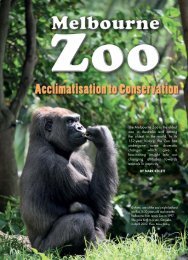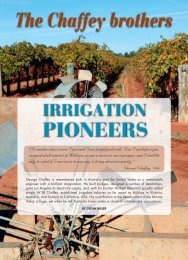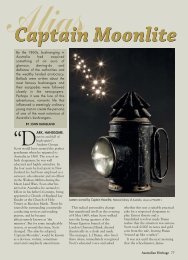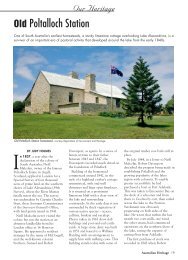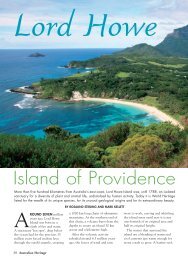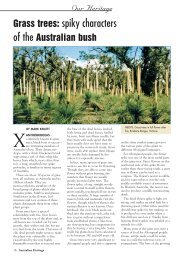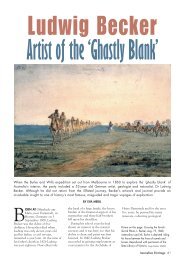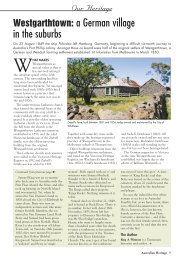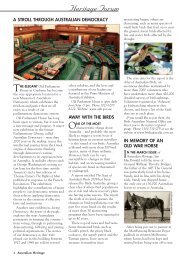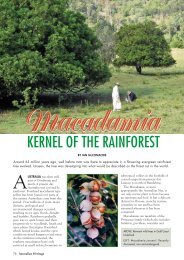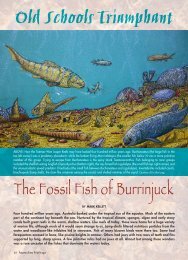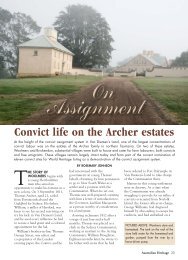Heritage1206_Noteworthy Mary Gilmore.pdf - Australian Heritage ...
Heritage1206_Noteworthy Mary Gilmore.pdf - Australian Heritage ...
Heritage1206_Noteworthy Mary Gilmore.pdf - Australian Heritage ...
You also want an ePaper? Increase the reach of your titles
YUMPU automatically turns print PDFs into web optimized ePapers that Google loves.
<strong>Noteworthy</strong> People<br />
were to have the greatest influence on<br />
her life – William Lane, the founder of<br />
New Australia, the socialist<br />
community in Paraguay; Louisa<br />
Lawson, who was friendly with her<br />
mother; and through Louisa, her son,<br />
Henry Lawson. A strong attachment<br />
grew between <strong>Mary</strong> and Henry and,<br />
according to <strong>Mary</strong>, “he said he fell in<br />
love with me at first sight”.<br />
The two spent much time in each<br />
other’s company, and Henry<br />
introduced <strong>Mary</strong> to the poorer<br />
working class areas of Sydney<br />
including the Rocks area.<br />
He used to take me out to see the<br />
wrong things, the things repressive of<br />
the rights of Australia; the things like<br />
a blot upon her and which prevented<br />
her being herself – the low wage<br />
workers, the Chinamen working at<br />
treadle-saws in underground cellars lit<br />
only by a grating in the street, the<br />
huddled houses by the old Argyle Cut,<br />
and the Rocks where women hung<br />
their washing out on the roof and<br />
from the windows, and where pale<br />
seamstresses sewed at a foot or a hand<br />
machine from daylight till dark for a<br />
few pence and, last but not least, the<br />
mixture of blood and the neglected<br />
children of the Quay and elsewhere.<br />
<strong>Mary</strong> later wrote that Henry<br />
proposed to her but she refused.<br />
1890 was a tumultuous year for<br />
Australia, with the growth of the<br />
trade union movement and the<br />
formation of employers’ groups<br />
leading to the maritime strike which<br />
spread across the nation in August of<br />
that year. Foremost among the union<br />
leaders was William Lane, an<br />
Englishman who had emigrated in<br />
1885 to Brisbane, where he worked as<br />
a freelance journalist for mainstream<br />
and workers’ publications, and<br />
launched his own socialist newspaper,<br />
The Boomerang.<br />
He played a leading role in growing<br />
the Queensland union movement and<br />
edited the union newspaper, The<br />
Worker. Following the collapse of the<br />
Shearers’ Strike in 1891, and<br />
disillusioned with the entrenched<br />
social and economic divide in<br />
Australia, Lane and a handful of other<br />
socialists founded The ‘New Australia<br />
Cooperative Settlement Association’<br />
with the aim of creating a utopian<br />
communist society.<br />
The group decided it would be<br />
necessary to leave Australia and<br />
Paraguay was settled upon when a<br />
parcel of land was offered by the<br />
Paraguayan government on condition<br />
that a minimum number of people<br />
settled there. The Association set<br />
about attracting recruits to the new<br />
colony and acquiring a ship, the Royal<br />
Tar, to transport them.<br />
It was in 1892 that <strong>Mary</strong> Cameron<br />
met and was evidently deeply<br />
impressed by William Lane.<br />
Earnest, strong in conviction,<br />
generous-hearted and tender-hearted.<br />
A man to whom Truth is more than<br />
all else – not only truth in word and<br />
deed but in the fulfillment of creation.<br />
….A man with whom utter kindliness<br />
abides. It is good to have touched his<br />
hand.<br />
When the headquarters of the New<br />
Australia Co-operative Settlement<br />
Association moved to Sydney in 1893,<br />
<strong>Mary</strong> started writing for its journal,<br />
New Australia. Meanwhile, somewhat<br />
chaotic preparations were under way<br />
for the first group of 220 emigrants to<br />
be shipped to Paraguay, and they<br />
finally set sail under Lane’s leadership<br />
on 16 July 1893. <strong>Mary</strong> was unable to<br />
join them as single women were<br />
excluded from this first trip.<br />
Over the following months, <strong>Mary</strong><br />
became a key protagonist for the new<br />
settlement, but all was not well within<br />
the emigrant community. Even during<br />
the voyage, signs of discord emerged as<br />
some of the settlers expressed<br />
resentment at Lane’s strict moral code<br />
and somewhat authoritarian attitude.<br />
Things got worse after their arrival in<br />
September and, by mid-December,<br />
Lane had expelled three men for<br />
breaking the temperance rule. By the<br />
end of the year, more than a third of<br />
the settlers had seceded. A second<br />
group of 199 emigrants set out from<br />
Adelaide on New Year’s Eve, arriving<br />
in late February 1894, but their arrival<br />
A group of people, including <strong>Mary</strong> <strong>Gilmore</strong>, at the New Australia Colony, Cosme, Paraguay, 1890s. Photograph; 10.1 x 15.5 cm. National Library of<br />
Australia, nla.pic-an24636968.<br />
26 <strong>Australian</strong> <strong>Heritage</strong>



